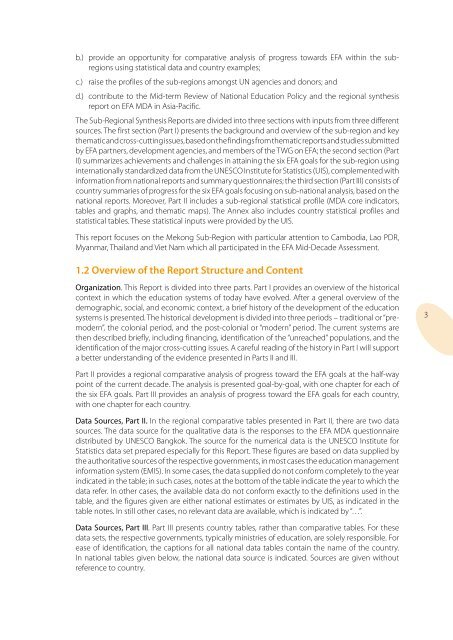Asia and the Pacific Education for All (EFA) mid-decade assessment ...
Asia and the Pacific Education for All (EFA) mid-decade assessment ...
Asia and the Pacific Education for All (EFA) mid-decade assessment ...
You also want an ePaper? Increase the reach of your titles
YUMPU automatically turns print PDFs into web optimized ePapers that Google loves.
.) provide an opportunity <strong>for</strong> comparative analysis of progress towards <strong>EFA</strong> within <strong>the</strong> sub-<br />
regions using statistical data <strong>and</strong> country examples;<br />
c.)<br />
raise <strong>the</strong> profiles of <strong>the</strong> sub-regions amongst UN agencies <strong>and</strong> donors; <strong>and</strong><br />
d.) contribute to <strong>the</strong> Mid-term Review of National <strong>Education</strong> Policy <strong>and</strong> <strong>the</strong> regional syn<strong>the</strong>sis<br />
report on <strong>EFA</strong> MDA in <strong>Asia</strong>-<strong>Pacific</strong>.<br />
The Sub-Regional Syn<strong>the</strong>sis Reports are divided into three sections with inputs from three different<br />
sources. The first section (Part I) presents <strong>the</strong> background <strong>and</strong> overview of <strong>the</strong> sub-region <strong>and</strong> key<br />
<strong>the</strong>matic <strong>and</strong> cross-cutting issues, based on <strong>the</strong> findings from <strong>the</strong>matic reports <strong>and</strong> studies submitted<br />
by <strong>EFA</strong> partners, development agencies, <strong>and</strong> members of <strong>the</strong> TWG on <strong>EFA</strong>; <strong>the</strong> second section (Part<br />
II) summarizes achievements <strong>and</strong> challenges in attaining <strong>the</strong> six <strong>EFA</strong> goals <strong>for</strong> <strong>the</strong> sub-region using<br />
internationally st<strong>and</strong>ardized data from <strong>the</strong> UNESCO Institute <strong>for</strong> Statistics (UIS), complemented with<br />
in<strong>for</strong>mation from national reports <strong>and</strong> summary questionnaires; <strong>the</strong> third section (Part III) consists of<br />
country summaries of progress <strong>for</strong> <strong>the</strong> six <strong>EFA</strong> goals focusing on sub-national analysis, based on <strong>the</strong><br />
national reports. Moreover, Part II includes a sub-regional statistical profile (MDA core indicators,<br />
tables <strong>and</strong> graphs, <strong>and</strong> <strong>the</strong>matic maps). The Annex also includes country statistical profiles <strong>and</strong><br />
statistical tables. These statistical inputs were provided by <strong>the</strong> UIS.<br />
This report focuses on <strong>the</strong> Mekong Sub-Region with particular attention to Cambodia, Lao PDR,<br />
Myanmar, Thail<strong>and</strong> <strong>and</strong> Viet Nam which all participated in <strong>the</strong> <strong>EFA</strong> Mid-Decade Assessment.<br />
1.2 Overview of <strong>the</strong> Report Structure <strong>and</strong> Content<br />
Organization. This Report is divided into three parts. Part I provides an overview of <strong>the</strong> historical<br />
context in which <strong>the</strong> education systems of today have evolved. After a general overview of <strong>the</strong><br />
demographic, social, <strong>and</strong> economic context, a brief history of <strong>the</strong> develop ment of <strong>the</strong> education<br />
systems is presented. The historical development is divided into three periods – traditional or “premodern”,<br />
<strong>the</strong> colonial period, <strong>and</strong> <strong>the</strong> post-colonial or “modern” period. The current systems are<br />
<strong>the</strong>n described briefly, including financing, identification of <strong>the</strong> “unreached” populations, <strong>and</strong> <strong>the</strong><br />
identification of <strong>the</strong> major cross-cutting issues. A careful reading of <strong>the</strong> history in Part I will support<br />
a better underst<strong>and</strong>ing of <strong>the</strong> evidence presented in Parts II <strong>and</strong> III.<br />
3<br />
Part II provides a regional comparative analysis of progress toward <strong>the</strong> <strong>EFA</strong> goals at <strong>the</strong> half-way<br />
point of <strong>the</strong> current <strong>decade</strong>. The analysis is presented goal-by-goal, with one chapter <strong>for</strong> each of<br />
<strong>the</strong> six <strong>EFA</strong> goals. Part III provides an analysis of progress toward <strong>the</strong> <strong>EFA</strong> goals <strong>for</strong> each country,<br />
with one chapter <strong>for</strong> each country.<br />
Data Sources, Part II. In <strong>the</strong> regional comparative tables presented in Part II, <strong>the</strong>re are two data<br />
sources. The data source <strong>for</strong> <strong>the</strong> qualitative data is <strong>the</strong> responses to <strong>the</strong> <strong>EFA</strong> MDA questionnaire<br />
distributed by UNESCO Bangkok. The source <strong>for</strong> <strong>the</strong> numerical data is <strong>the</strong> UNESCO Institute <strong>for</strong><br />
Statistics data set prepared especially <strong>for</strong> this Report. These figures are based on data supplied by<br />
<strong>the</strong> authoritative sources of <strong>the</strong> respective governments, in most cases <strong>the</strong> education management<br />
in<strong>for</strong>mation system (EMIS). In some cases, <strong>the</strong> data supplied do not con<strong>for</strong>m completely to <strong>the</strong> year<br />
indicated in <strong>the</strong> table; in such cases, notes at <strong>the</strong> bottom of <strong>the</strong> table indicate <strong>the</strong> year to which <strong>the</strong><br />
data refer. In o<strong>the</strong>r cases, <strong>the</strong> available data do not con<strong>for</strong>m exactly to <strong>the</strong> definitions used in <strong>the</strong><br />
table, <strong>and</strong> <strong>the</strong> figures given are ei<strong>the</strong>r national estimates or estimates by UIS, as indicated in <strong>the</strong><br />
table notes. In still o<strong>the</strong>r cases, no relevant data are available, which is indicated by “…”.<br />
Data Sources, Part III. Part III presents country tables, ra<strong>the</strong>r than comparative tables. For <strong>the</strong>se<br />
data sets, <strong>the</strong> respective governments, typically ministries of education, are solely responsible. For<br />
ease of identification, <strong>the</strong> captions <strong>for</strong> all national data tables contain <strong>the</strong> name of <strong>the</strong> country.<br />
In national tables given below, <strong>the</strong> national data source is indicated. Sources are given without<br />
reference to country.

















